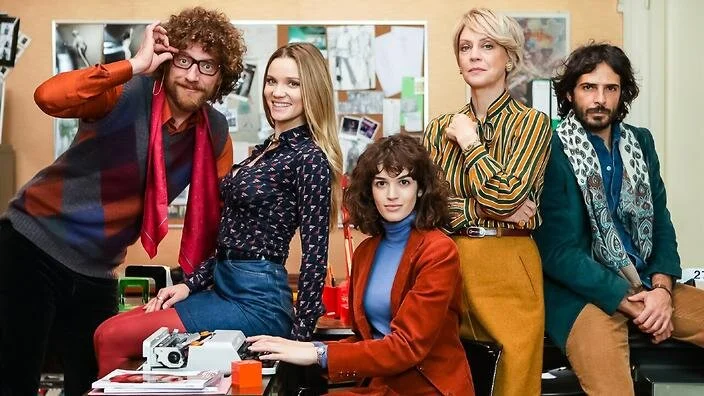Talking About: Made In Italy
Why We Chose This Series
SBS On Demand’s Made in Italy is set in the ’70s and charts the days when Milan’s fashion scene was starting to attract global attention. In eight episodes it follows the adventures of Irene Mastrangelo, a young journalist from the south of Italy, who scores a job at a prestigious fashion magazine. There’s a bit of romance, a bit of politics and a whole lot of fabulous fashion.
The Participants
Carlotta, Aileen and Ute
Ute You know how long it took me to love this show? The opening credits. They looked so great, I decided I was going to love this. But when I mentioned it to you, Carlotta, you said, “It’s crap.” I think you’d only watched one episode at the time. Have you changed your mind?
Carlotta Yes I have. At first I thought, This is a cheesy Italian version of The Devil Wears Prada. But once I got to the start of episode two, I was hooked. Sometimes it takes me a while to get into a show because character development is everything for me, and I love all the characters in this.
Aileen I agree. I thought the first episode was a bit cheesy but by the second one I thought, with this nice light drama we can go down memory lane.
C The details in this show are incredible. I love that about 80 per cent of the main characters’ costumes are actually from designers’ archives. They’re the real deal.
U So all those ’70s pieces by Versace and Valentino are genuine?
C Yeah, they put a lot of effort into getting it as legit as they could. The way the magazine was set up was also authentic. Those editorial meetings are what editorial meetings are really like, the art meeting is what art meetings are like. They even cast Wayne Maser as [fashion photographer] Richard Avedon, and Wayne Maser is actually a fashion photographer still working today!
A OMG, was that Wayne Maser? I’ve worked with him. I didn’t recognise him!
C He once crashed a dinner I was at in Beaver Creek, Colarado. We were there for a magazine shoot and our model was dating a Rothschild so she flew in with Wayne in a private jet and joined us for dinner.
U For me the story was interesting because it’s set in the era when Milan fashion is really beginning. I think of Italian fashion as almost eternal, but at this point in time Paris was still getting all the attention. Did you guys know a lot about that?
A I realised that Italy was in the shadow of Paris but I didn’t realise that Milan hadn’t already established itself as a capital of fashion, because when I got into fashion in the ’80s, Italy was well established. The fact that they had nothing to lose, I think, encouraged them to be more out there and take more chances.
C The series shows that Italy was going through a revolution in the streets, and the lead character Irene is going through a personal battle about how she fits in as a woman in Italian society. Her parents are very traditional; her mother is a seamstress but she would never think of designing her own collection. She’s a wife and a mother and she does this on the side. But Irene wants to get out and live, and once she gets the job at the magazine, she is surrounded by creative, forward-thinking people. She blossoms and begins to dream big.
U It reminded me of Paper Giants, which was about the birth of Cleo magazine. It is interesting how fashion and magazines can be used as a vehicle for summoning up changing women’s roles in society. During this period in Italian history there was terrorism, there were riots in the streets; I wonder if a lot of younger Italians are aware of that history, or if they watched the show and said to their parents, “Really, you went through that?” But you also get into the individual stories of the characters. Rita with the issues with her son, Irene’s friend Monica had a backstory, the art director had some darkness in his life…
C And the story for that beautiful male model, Flavio, turned sour as well. Drugs and underground gay bars…
A I also really loved the street casting for the fashion shoot. We’ve gone full circle: this is where we are at again, including the rolling rack on the street. Hello, that’s my life!
U I loved the amazing designer gowns, but I also enjoyed watching the wardrobes of the characters, which all told you something about their personalities.
A And when Irene would help herself to the clothes rack [of items for the photo shoots] and be, “Oh, I’ll just borrow this for the night…”
C That NEVER happens, does it Ails…
A No, no… shh.
C The locations were beautiful, and I also loved the gorgeous warm tones it was shot in.
A You described it like being wrapped in cashmere, and I thought, Yes! You also realise to this day that Italy drives the market with regard to textiles and textile production.
C That reminds me: the scene where they go to the Missoni factory was actually shot in the Missoni factory! They take us into the workshop where they weave the fabrics. It was so beautiful to see.
U I don’t know if there is a second series but, gosh, it would be exciting to follow it into the ’80s, wouldn’t it?
A The era of diffusion brands and street fashion.
C Watching Made in Italy inspired me to continue to dream. When we started at Dolly we all had such big dreams, we thought we could take on the world. But as you get older you get worn down and thoughts of “not possible” seep in. But it makes me believe in keeping the dream alive and going for it.

